Health Behaviour Change Reflection: Eating More Fruits and Vegetables
VerifiedAdded on 2021/06/17
|15
|4099
|114
Report
AI Summary
This report presents a student's reflection on changing health behaviors, specifically focusing on increasing the intake of fruits and vegetables. The report begins with a diary entry detailing the desired health behavior change, the reasons behind it, and the ways to achieve it, including short-term and long-term goals. It explores the positive and negative impacts of this change on health and lifestyle, documenting weekly progress and identifying barriers encountered. The core of the report is a reflection on the change journey, analyzing facilitators and barriers to achieving the goals. The student discusses the importance of self-reflection in overcoming obstacles and provides insights into the Australian dietary guidelines regarding fruit and vegetable consumption. The report references various studies and literature to support the arguments and findings, offering a comprehensive analysis of the health behavior change process and its implications.
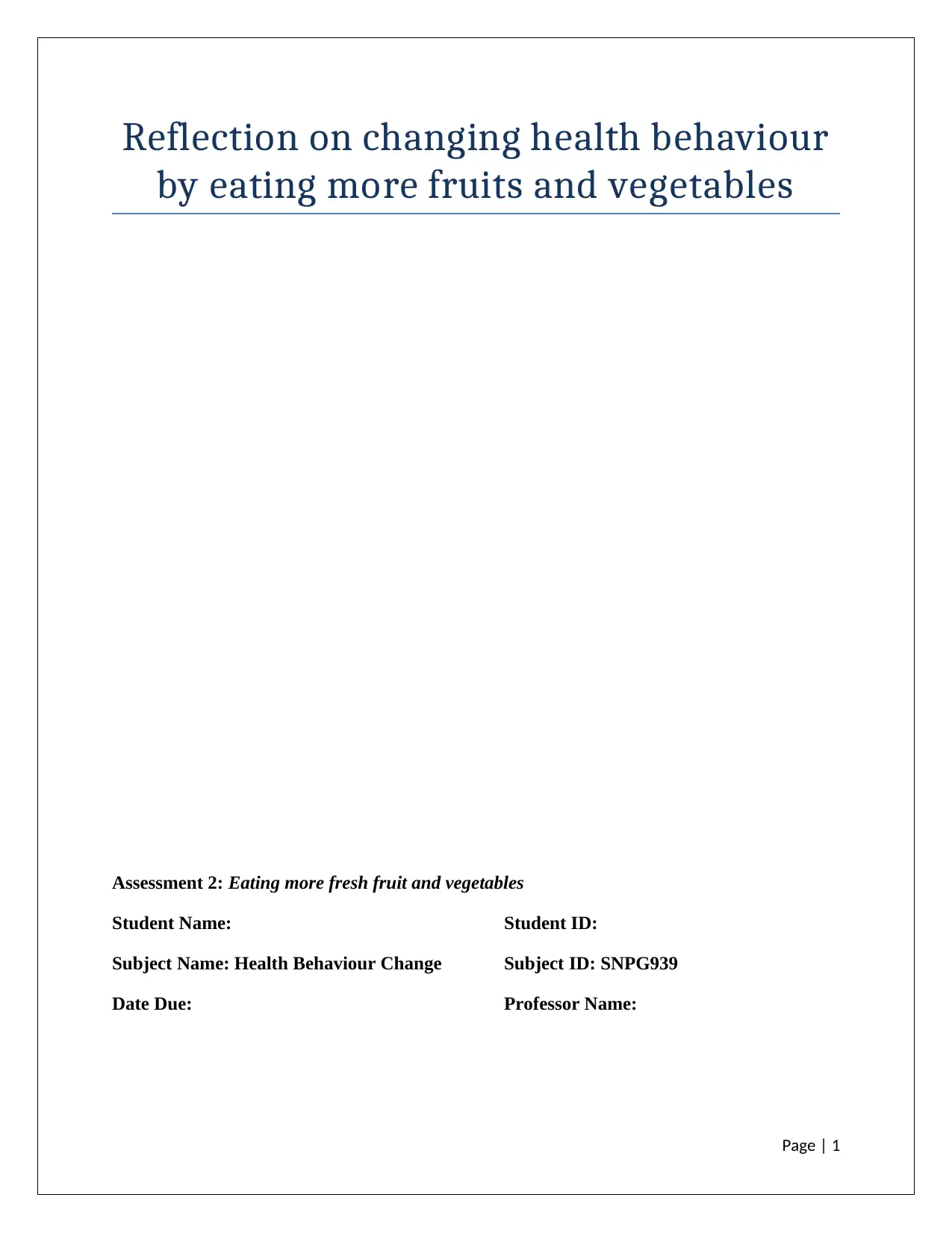
Reflection on changing health behaviour
by eating more fruits and vegetables
Assessment 2: Eating more fresh fruit and vegetables
Student Name: Student ID:
Subject Name: Health Behaviour Change Subject ID: SNPG939
Date Due: Professor Name:
Page | 1
by eating more fruits and vegetables
Assessment 2: Eating more fresh fruit and vegetables
Student Name: Student ID:
Subject Name: Health Behaviour Change Subject ID: SNPG939
Date Due: Professor Name:
Page | 1
Paraphrase This Document
Need a fresh take? Get an instant paraphrase of this document with our AI Paraphraser
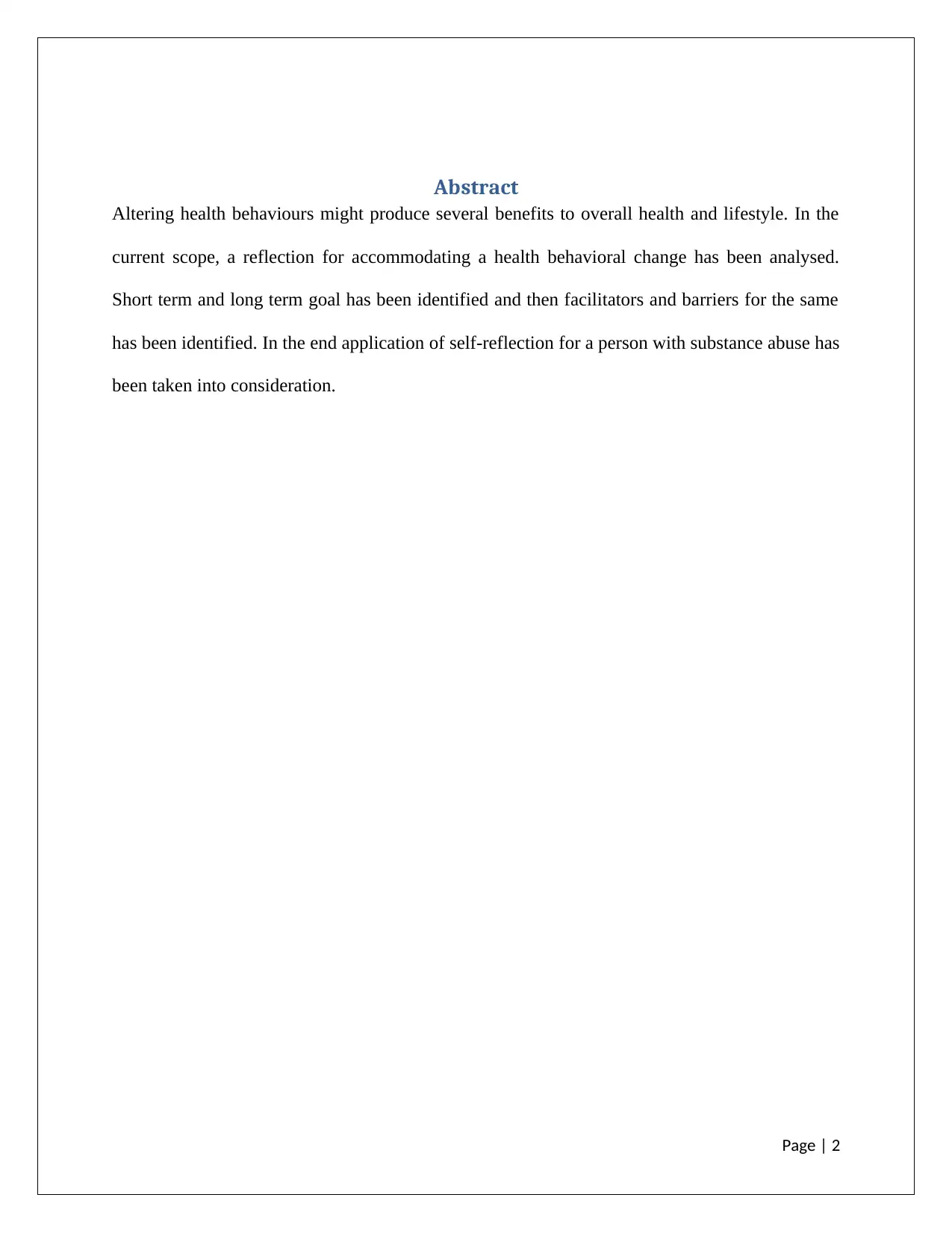
Abstract
Altering health behaviours might produce several benefits to overall health and lifestyle. In the
current scope, a reflection for accommodating a health behavioral change has been analysed.
Short term and long term goal has been identified and then facilitators and barriers for the same
has been identified. In the end application of self-reflection for a person with substance abuse has
been taken into consideration.
Page | 2
Altering health behaviours might produce several benefits to overall health and lifestyle. In the
current scope, a reflection for accommodating a health behavioral change has been analysed.
Short term and long term goal has been identified and then facilitators and barriers for the same
has been identified. In the end application of self-reflection for a person with substance abuse has
been taken into consideration.
Page | 2
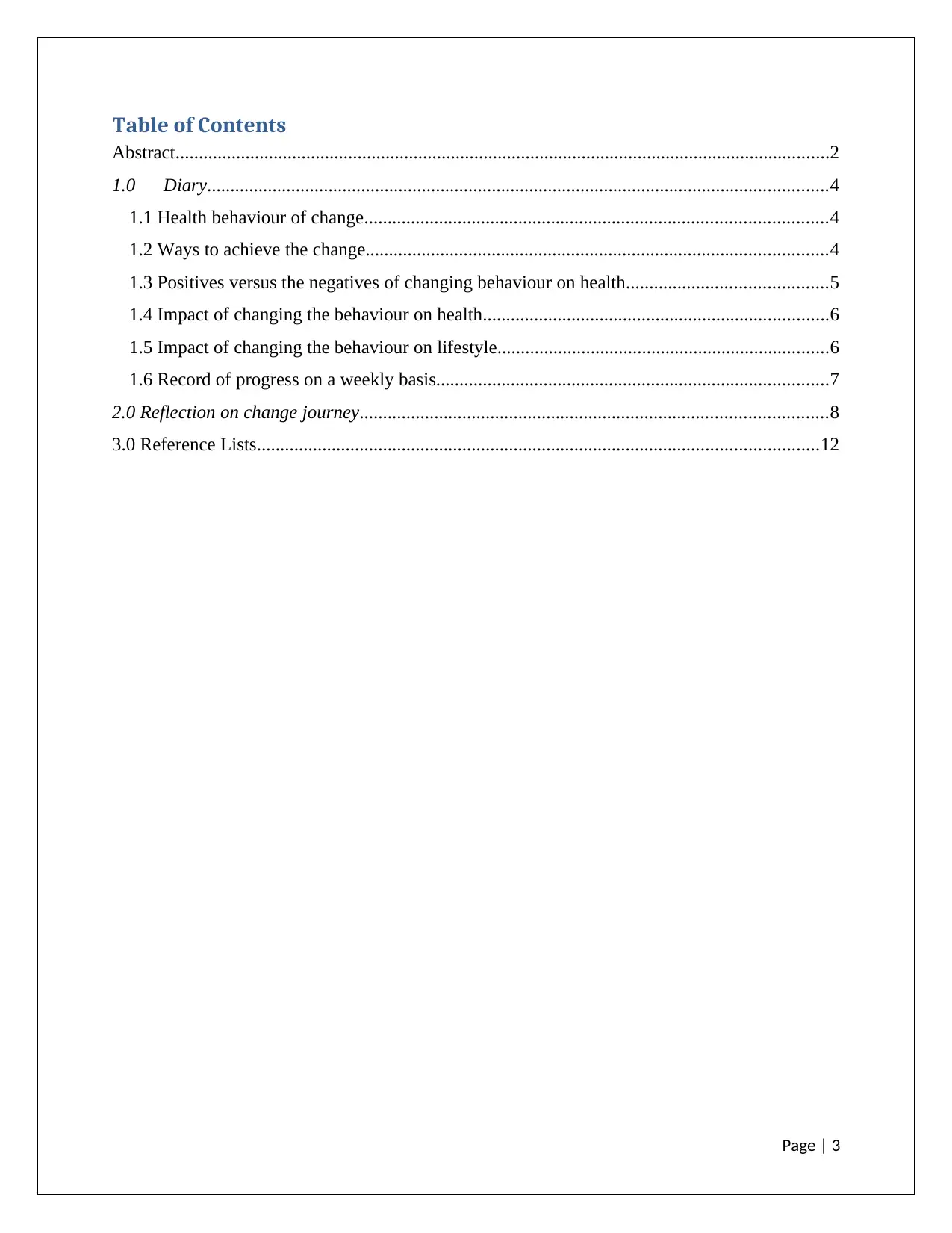
Table of Contents
Abstract............................................................................................................................................2
1.0 Diary.....................................................................................................................................4
1.1 Health behaviour of change...................................................................................................4
1.2 Ways to achieve the change...................................................................................................4
1.3 Positives versus the negatives of changing behaviour on health...........................................5
1.4 Impact of changing the behaviour on health..........................................................................6
1.5 Impact of changing the behaviour on lifestyle.......................................................................6
1.6 Record of progress on a weekly basis....................................................................................7
2.0 Reflection on change journey....................................................................................................8
3.0 Reference Lists........................................................................................................................12
Page | 3
Abstract............................................................................................................................................2
1.0 Diary.....................................................................................................................................4
1.1 Health behaviour of change...................................................................................................4
1.2 Ways to achieve the change...................................................................................................4
1.3 Positives versus the negatives of changing behaviour on health...........................................5
1.4 Impact of changing the behaviour on health..........................................................................6
1.5 Impact of changing the behaviour on lifestyle.......................................................................6
1.6 Record of progress on a weekly basis....................................................................................7
2.0 Reflection on change journey....................................................................................................8
3.0 Reference Lists........................................................................................................................12
Page | 3
⊘ This is a preview!⊘
Do you want full access?
Subscribe today to unlock all pages.

Trusted by 1+ million students worldwide
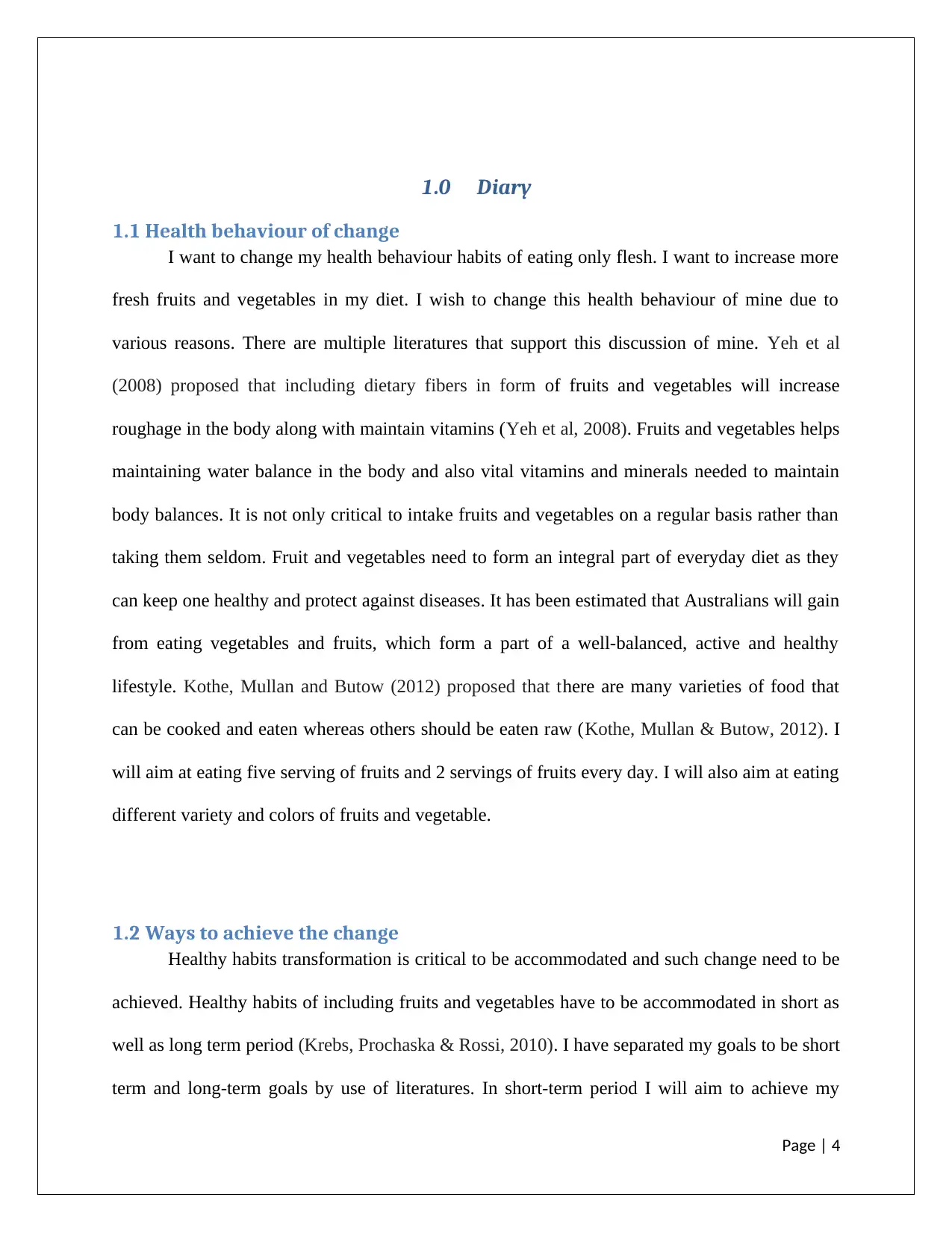
1.0 Diary
1.1 Health behaviour of change
I want to change my health behaviour habits of eating only flesh. I want to increase more
fresh fruits and vegetables in my diet. I wish to change this health behaviour of mine due to
various reasons. There are multiple literatures that support this discussion of mine. Yeh et al
(2008) proposed that including dietary fibers in form of fruits and vegetables will increase
roughage in the body along with maintain vitamins (Yeh et al, 2008). Fruits and vegetables helps
maintaining water balance in the body and also vital vitamins and minerals needed to maintain
body balances. It is not only critical to intake fruits and vegetables on a regular basis rather than
taking them seldom. Fruit and vegetables need to form an integral part of everyday diet as they
can keep one healthy and protect against diseases. It has been estimated that Australians will gain
from eating vegetables and fruits, which form a part of a well-balanced, active and healthy
lifestyle. Kothe, Mullan and Butow (2012) proposed that there are many varieties of food that
can be cooked and eaten whereas others should be eaten raw (Kothe, Mullan & Butow, 2012). I
will aim at eating five serving of fruits and 2 servings of fruits every day. I will also aim at eating
different variety and colors of fruits and vegetable.
1.2 Ways to achieve the change
Healthy habits transformation is critical to be accommodated and such change need to be
achieved. Healthy habits of including fruits and vegetables have to be accommodated in short as
well as long term period (Krebs, Prochaska & Rossi, 2010). I have separated my goals to be short
term and long-term goals by use of literatures. In short-term period I will aim to achieve my
Page | 4
1.1 Health behaviour of change
I want to change my health behaviour habits of eating only flesh. I want to increase more
fresh fruits and vegetables in my diet. I wish to change this health behaviour of mine due to
various reasons. There are multiple literatures that support this discussion of mine. Yeh et al
(2008) proposed that including dietary fibers in form of fruits and vegetables will increase
roughage in the body along with maintain vitamins (Yeh et al, 2008). Fruits and vegetables helps
maintaining water balance in the body and also vital vitamins and minerals needed to maintain
body balances. It is not only critical to intake fruits and vegetables on a regular basis rather than
taking them seldom. Fruit and vegetables need to form an integral part of everyday diet as they
can keep one healthy and protect against diseases. It has been estimated that Australians will gain
from eating vegetables and fruits, which form a part of a well-balanced, active and healthy
lifestyle. Kothe, Mullan and Butow (2012) proposed that there are many varieties of food that
can be cooked and eaten whereas others should be eaten raw (Kothe, Mullan & Butow, 2012). I
will aim at eating five serving of fruits and 2 servings of fruits every day. I will also aim at eating
different variety and colors of fruits and vegetable.
1.2 Ways to achieve the change
Healthy habits transformation is critical to be accommodated and such change need to be
achieved. Healthy habits of including fruits and vegetables have to be accommodated in short as
well as long term period (Krebs, Prochaska & Rossi, 2010). I have separated my goals to be short
term and long-term goals by use of literatures. In short-term period I will aim to achieve my
Page | 4
Paraphrase This Document
Need a fresh take? Get an instant paraphrase of this document with our AI Paraphraser
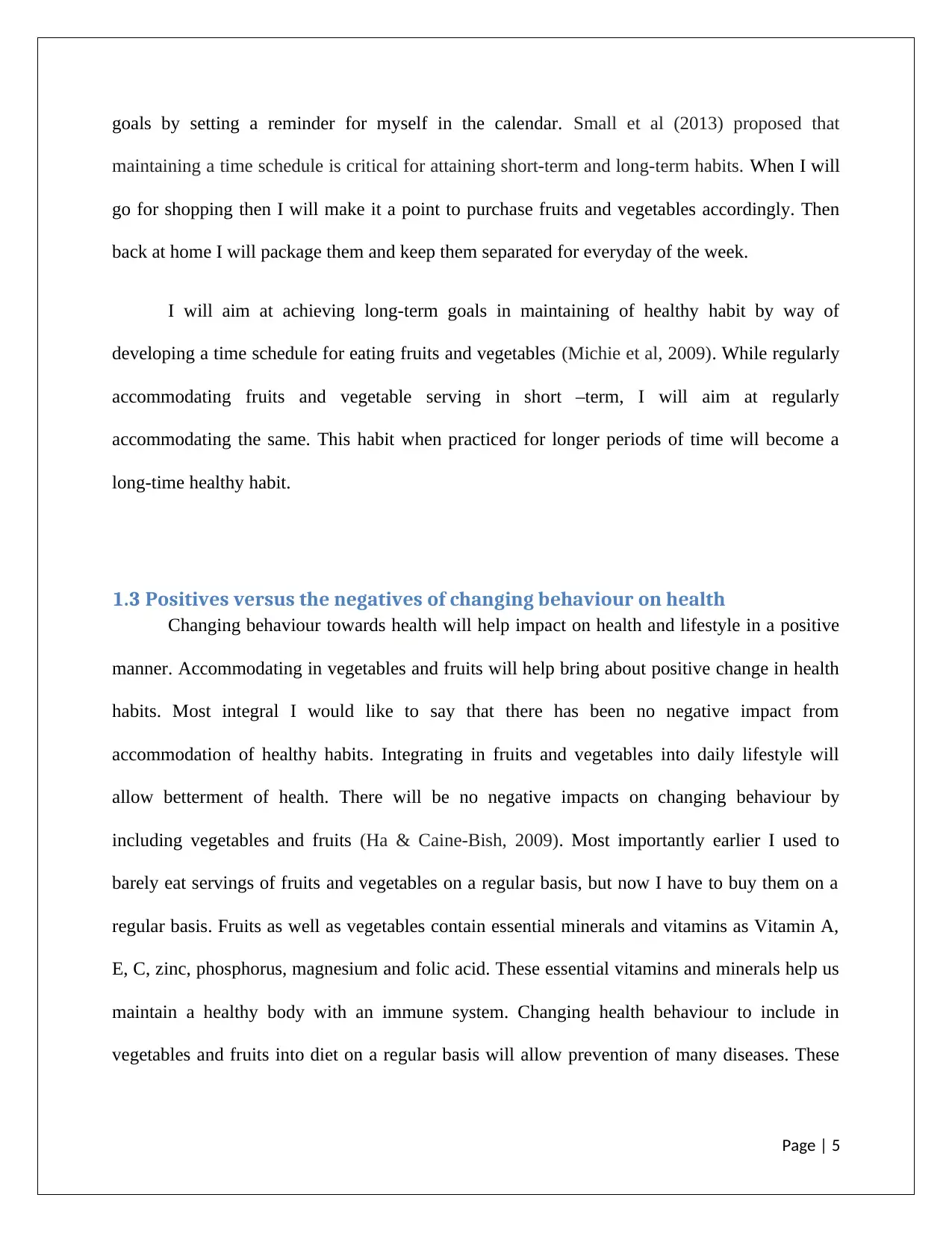
goals by setting a reminder for myself in the calendar. Small et al (2013) proposed that
maintaining a time schedule is critical for attaining short-term and long-term habits. When I will
go for shopping then I will make it a point to purchase fruits and vegetables accordingly. Then
back at home I will package them and keep them separated for everyday of the week.
I will aim at achieving long-term goals in maintaining of healthy habit by way of
developing a time schedule for eating fruits and vegetables (Michie et al, 2009). While regularly
accommodating fruits and vegetable serving in short –term, I will aim at regularly
accommodating the same. This habit when practiced for longer periods of time will become a
long-time healthy habit.
1.3 Positives versus the negatives of changing behaviour on health
Changing behaviour towards health will help impact on health and lifestyle in a positive
manner. Accommodating in vegetables and fruits will help bring about positive change in health
habits. Most integral I would like to say that there has been no negative impact from
accommodation of healthy habits. Integrating in fruits and vegetables into daily lifestyle will
allow betterment of health. There will be no negative impacts on changing behaviour by
including vegetables and fruits (Ha & Caine-Bish, 2009). Most importantly earlier I used to
barely eat servings of fruits and vegetables on a regular basis, but now I have to buy them on a
regular basis. Fruits as well as vegetables contain essential minerals and vitamins as Vitamin A,
E, C, zinc, phosphorus, magnesium and folic acid. These essential vitamins and minerals help us
maintain a healthy body with an immune system. Changing health behaviour to include in
vegetables and fruits into diet on a regular basis will allow prevention of many diseases. These
Page | 5
maintaining a time schedule is critical for attaining short-term and long-term habits. When I will
go for shopping then I will make it a point to purchase fruits and vegetables accordingly. Then
back at home I will package them and keep them separated for everyday of the week.
I will aim at achieving long-term goals in maintaining of healthy habit by way of
developing a time schedule for eating fruits and vegetables (Michie et al, 2009). While regularly
accommodating fruits and vegetable serving in short –term, I will aim at regularly
accommodating the same. This habit when practiced for longer periods of time will become a
long-time healthy habit.
1.3 Positives versus the negatives of changing behaviour on health
Changing behaviour towards health will help impact on health and lifestyle in a positive
manner. Accommodating in vegetables and fruits will help bring about positive change in health
habits. Most integral I would like to say that there has been no negative impact from
accommodation of healthy habits. Integrating in fruits and vegetables into daily lifestyle will
allow betterment of health. There will be no negative impacts on changing behaviour by
including vegetables and fruits (Ha & Caine-Bish, 2009). Most importantly earlier I used to
barely eat servings of fruits and vegetables on a regular basis, but now I have to buy them on a
regular basis. Fruits as well as vegetables contain essential minerals and vitamins as Vitamin A,
E, C, zinc, phosphorus, magnesium and folic acid. These essential vitamins and minerals help us
maintain a healthy body with an immune system. Changing health behaviour to include in
vegetables and fruits into diet on a regular basis will allow prevention of many diseases. These
Page | 5
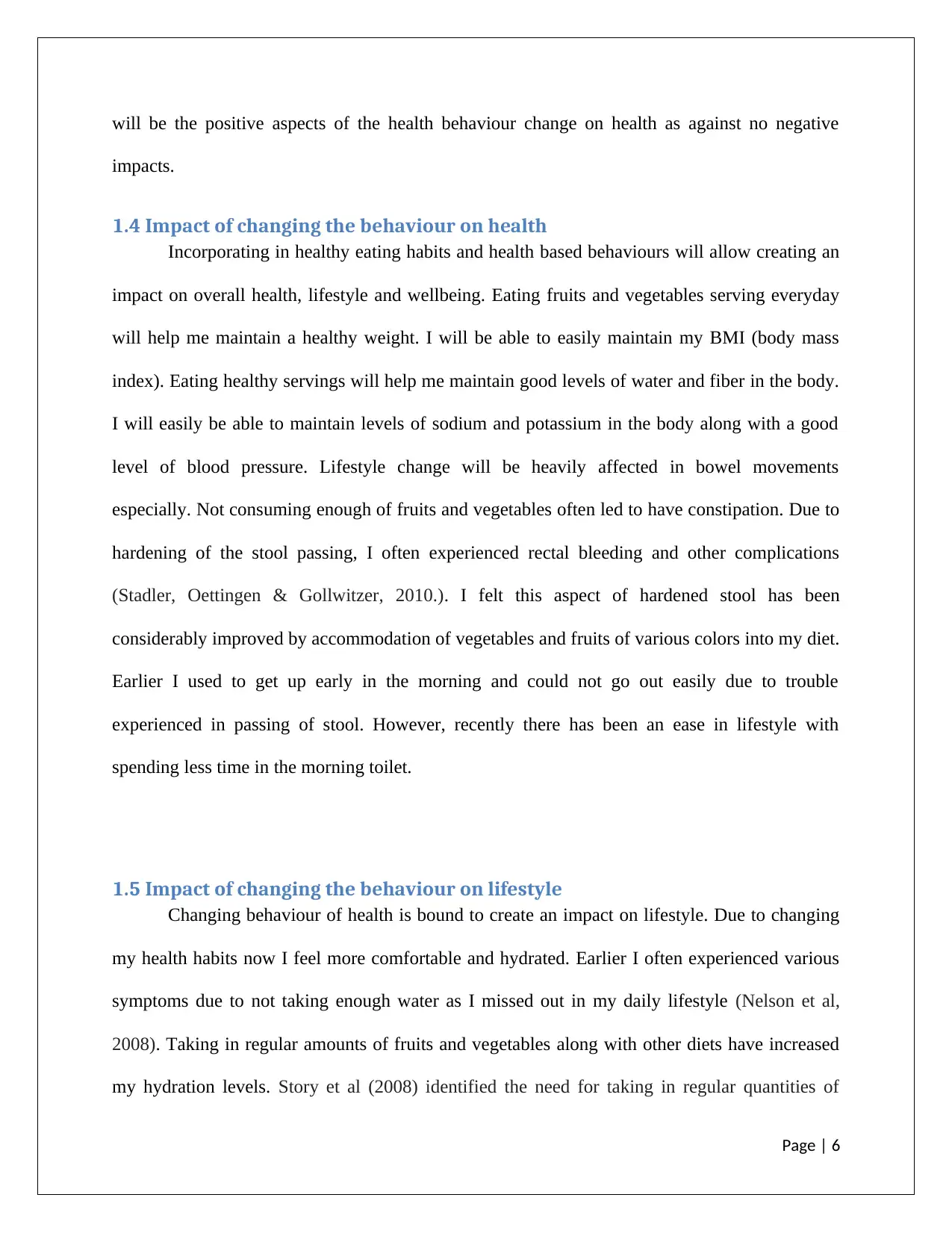
will be the positive aspects of the health behaviour change on health as against no negative
impacts.
1.4 Impact of changing the behaviour on health
Incorporating in healthy eating habits and health based behaviours will allow creating an
impact on overall health, lifestyle and wellbeing. Eating fruits and vegetables serving everyday
will help me maintain a healthy weight. I will be able to easily maintain my BMI (body mass
index). Eating healthy servings will help me maintain good levels of water and fiber in the body.
I will easily be able to maintain levels of sodium and potassium in the body along with a good
level of blood pressure. Lifestyle change will be heavily affected in bowel movements
especially. Not consuming enough of fruits and vegetables often led to have constipation. Due to
hardening of the stool passing, I often experienced rectal bleeding and other complications
(Stadler, Oettingen & Gollwitzer, 2010.). I felt this aspect of hardened stool has been
considerably improved by accommodation of vegetables and fruits of various colors into my diet.
Earlier I used to get up early in the morning and could not go out easily due to trouble
experienced in passing of stool. However, recently there has been an ease in lifestyle with
spending less time in the morning toilet.
1.5 Impact of changing the behaviour on lifestyle
Changing behaviour of health is bound to create an impact on lifestyle. Due to changing
my health habits now I feel more comfortable and hydrated. Earlier I often experienced various
symptoms due to not taking enough water as I missed out in my daily lifestyle (Nelson et al,
2008). Taking in regular amounts of fruits and vegetables along with other diets have increased
my hydration levels. Story et al (2008) identified the need for taking in regular quantities of
Page | 6
impacts.
1.4 Impact of changing the behaviour on health
Incorporating in healthy eating habits and health based behaviours will allow creating an
impact on overall health, lifestyle and wellbeing. Eating fruits and vegetables serving everyday
will help me maintain a healthy weight. I will be able to easily maintain my BMI (body mass
index). Eating healthy servings will help me maintain good levels of water and fiber in the body.
I will easily be able to maintain levels of sodium and potassium in the body along with a good
level of blood pressure. Lifestyle change will be heavily affected in bowel movements
especially. Not consuming enough of fruits and vegetables often led to have constipation. Due to
hardening of the stool passing, I often experienced rectal bleeding and other complications
(Stadler, Oettingen & Gollwitzer, 2010.). I felt this aspect of hardened stool has been
considerably improved by accommodation of vegetables and fruits of various colors into my diet.
Earlier I used to get up early in the morning and could not go out easily due to trouble
experienced in passing of stool. However, recently there has been an ease in lifestyle with
spending less time in the morning toilet.
1.5 Impact of changing the behaviour on lifestyle
Changing behaviour of health is bound to create an impact on lifestyle. Due to changing
my health habits now I feel more comfortable and hydrated. Earlier I often experienced various
symptoms due to not taking enough water as I missed out in my daily lifestyle (Nelson et al,
2008). Taking in regular amounts of fruits and vegetables along with other diets have increased
my hydration levels. Story et al (2008) identified the need for taking in regular quantities of
Page | 6
⊘ This is a preview!⊘
Do you want full access?
Subscribe today to unlock all pages.

Trusted by 1+ million students worldwide
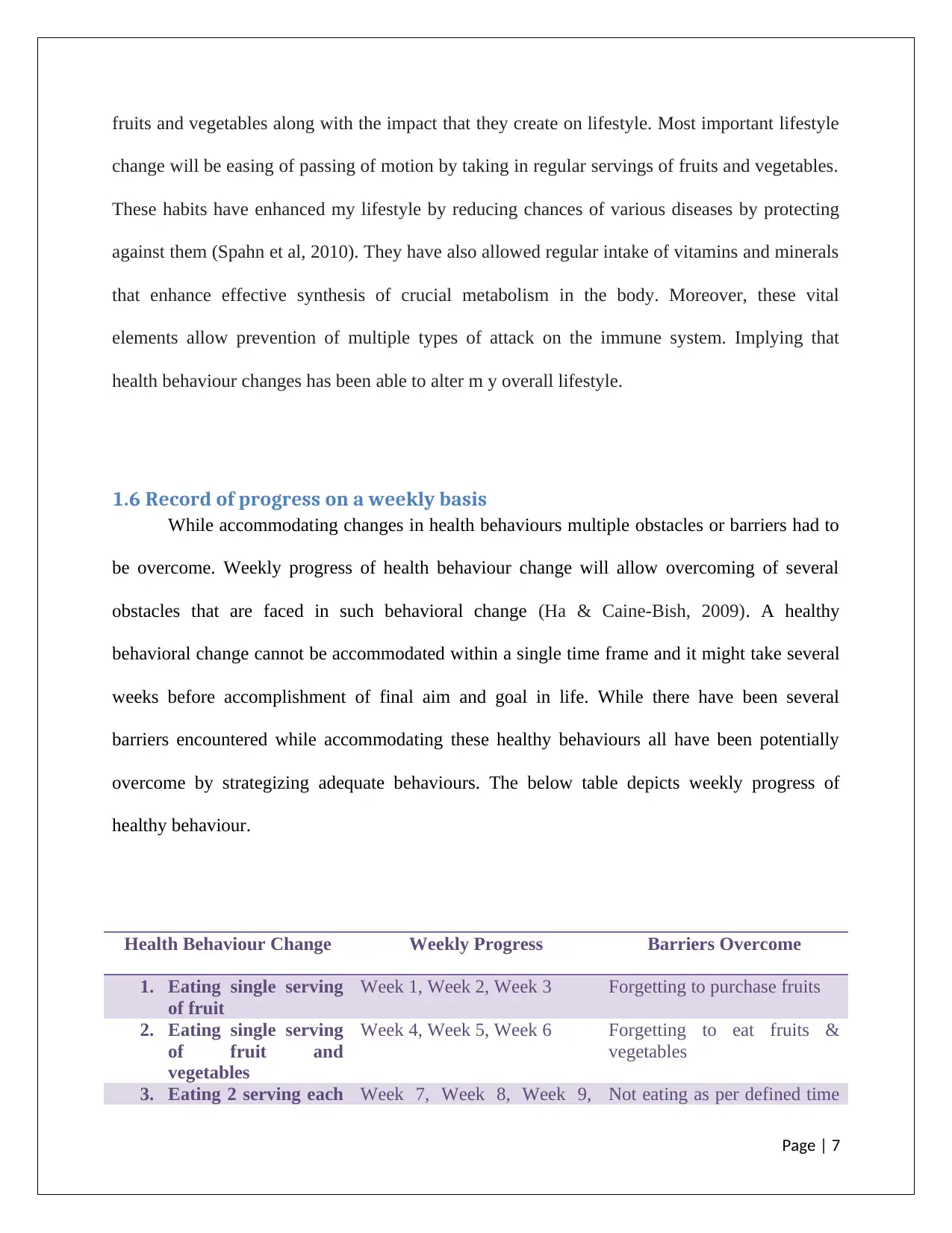
fruits and vegetables along with the impact that they create on lifestyle. Most important lifestyle
change will be easing of passing of motion by taking in regular servings of fruits and vegetables.
These habits have enhanced my lifestyle by reducing chances of various diseases by protecting
against them (Spahn et al, 2010). They have also allowed regular intake of vitamins and minerals
that enhance effective synthesis of crucial metabolism in the body. Moreover, these vital
elements allow prevention of multiple types of attack on the immune system. Implying that
health behaviour changes has been able to alter m y overall lifestyle.
1.6 Record of progress on a weekly basis
While accommodating changes in health behaviours multiple obstacles or barriers had to
be overcome. Weekly progress of health behaviour change will allow overcoming of several
obstacles that are faced in such behavioral change (Ha & Caine-Bish, 2009). A healthy
behavioral change cannot be accommodated within a single time frame and it might take several
weeks before accomplishment of final aim and goal in life. While there have been several
barriers encountered while accommodating these healthy behaviours all have been potentially
overcome by strategizing adequate behaviours. The below table depicts weekly progress of
healthy behaviour.
Health Behaviour Change Weekly Progress Barriers Overcome
1. Eating single serving
of fruit
Week 1, Week 2, Week 3 Forgetting to purchase fruits
2. Eating single serving
of fruit and
vegetables
Week 4, Week 5, Week 6 Forgetting to eat fruits &
vegetables
3. Eating 2 serving each Week 7, Week 8, Week 9, Not eating as per defined time
Page | 7
change will be easing of passing of motion by taking in regular servings of fruits and vegetables.
These habits have enhanced my lifestyle by reducing chances of various diseases by protecting
against them (Spahn et al, 2010). They have also allowed regular intake of vitamins and minerals
that enhance effective synthesis of crucial metabolism in the body. Moreover, these vital
elements allow prevention of multiple types of attack on the immune system. Implying that
health behaviour changes has been able to alter m y overall lifestyle.
1.6 Record of progress on a weekly basis
While accommodating changes in health behaviours multiple obstacles or barriers had to
be overcome. Weekly progress of health behaviour change will allow overcoming of several
obstacles that are faced in such behavioral change (Ha & Caine-Bish, 2009). A healthy
behavioral change cannot be accommodated within a single time frame and it might take several
weeks before accomplishment of final aim and goal in life. While there have been several
barriers encountered while accommodating these healthy behaviours all have been potentially
overcome by strategizing adequate behaviours. The below table depicts weekly progress of
healthy behaviour.
Health Behaviour Change Weekly Progress Barriers Overcome
1. Eating single serving
of fruit
Week 1, Week 2, Week 3 Forgetting to purchase fruits
2. Eating single serving
of fruit and
vegetables
Week 4, Week 5, Week 6 Forgetting to eat fruits &
vegetables
3. Eating 2 serving each Week 7, Week 8, Week 9, Not eating as per defined time
Page | 7
Paraphrase This Document
Need a fresh take? Get an instant paraphrase of this document with our AI Paraphraser
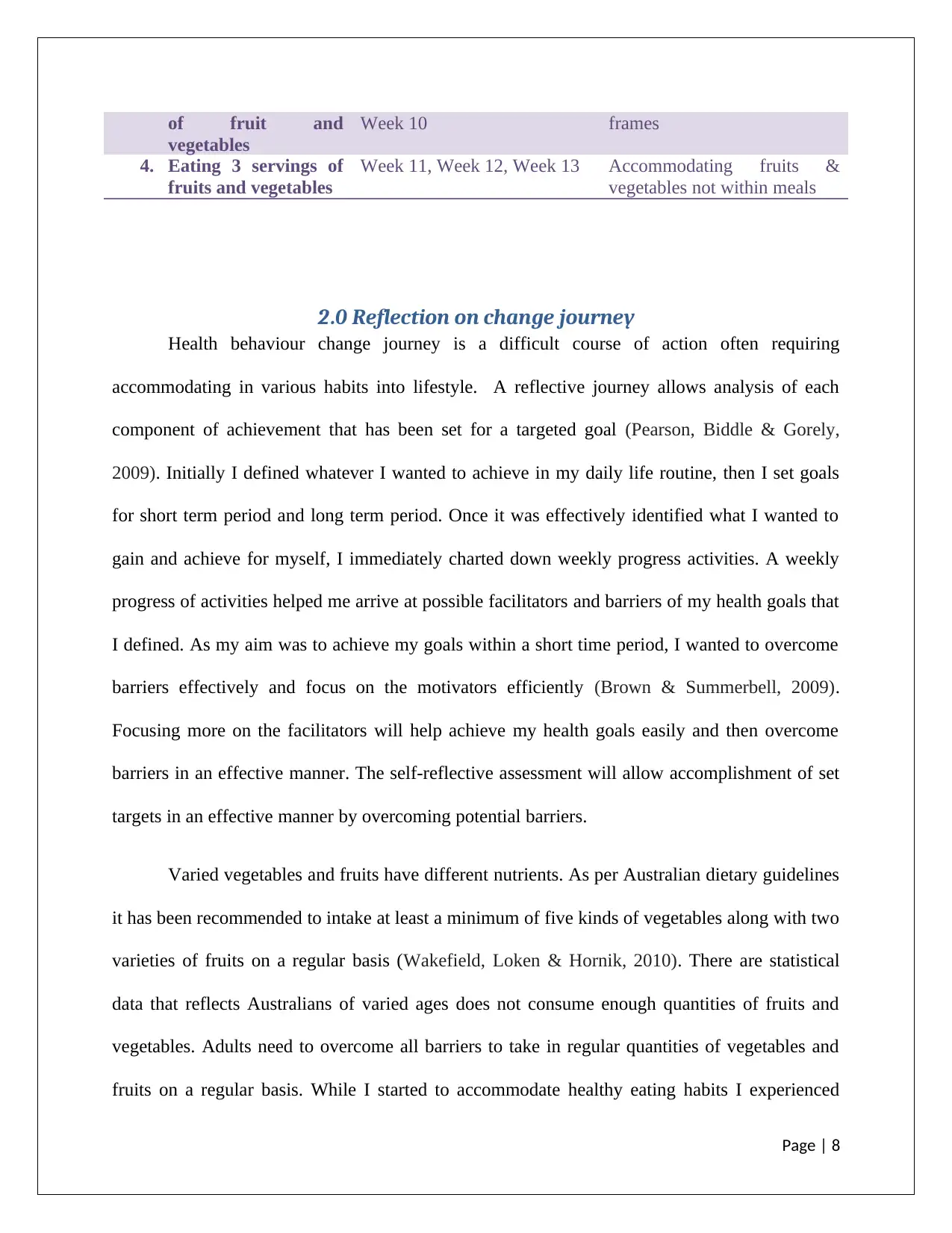
of fruit and
vegetables
Week 10 frames
4. Eating 3 servings of
fruits and vegetables
Week 11, Week 12, Week 13 Accommodating fruits &
vegetables not within meals
2.0 Reflection on change journey
Health behaviour change journey is a difficult course of action often requiring
accommodating in various habits into lifestyle. A reflective journey allows analysis of each
component of achievement that has been set for a targeted goal (Pearson, Biddle & Gorely,
2009). Initially I defined whatever I wanted to achieve in my daily life routine, then I set goals
for short term period and long term period. Once it was effectively identified what I wanted to
gain and achieve for myself, I immediately charted down weekly progress activities. A weekly
progress of activities helped me arrive at possible facilitators and barriers of my health goals that
I defined. As my aim was to achieve my goals within a short time period, I wanted to overcome
barriers effectively and focus on the motivators efficiently (Brown & Summerbell, 2009).
Focusing more on the facilitators will help achieve my health goals easily and then overcome
barriers in an effective manner. The self-reflective assessment will allow accomplishment of set
targets in an effective manner by overcoming potential barriers.
Varied vegetables and fruits have different nutrients. As per Australian dietary guidelines
it has been recommended to intake at least a minimum of five kinds of vegetables along with two
varieties of fruits on a regular basis (Wakefield, Loken & Hornik, 2010). There are statistical
data that reflects Australians of varied ages does not consume enough quantities of fruits and
vegetables. Adults need to overcome all barriers to take in regular quantities of vegetables and
fruits on a regular basis. While I started to accommodate healthy eating habits I experienced
Page | 8
vegetables
Week 10 frames
4. Eating 3 servings of
fruits and vegetables
Week 11, Week 12, Week 13 Accommodating fruits &
vegetables not within meals
2.0 Reflection on change journey
Health behaviour change journey is a difficult course of action often requiring
accommodating in various habits into lifestyle. A reflective journey allows analysis of each
component of achievement that has been set for a targeted goal (Pearson, Biddle & Gorely,
2009). Initially I defined whatever I wanted to achieve in my daily life routine, then I set goals
for short term period and long term period. Once it was effectively identified what I wanted to
gain and achieve for myself, I immediately charted down weekly progress activities. A weekly
progress of activities helped me arrive at possible facilitators and barriers of my health goals that
I defined. As my aim was to achieve my goals within a short time period, I wanted to overcome
barriers effectively and focus on the motivators efficiently (Brown & Summerbell, 2009).
Focusing more on the facilitators will help achieve my health goals easily and then overcome
barriers in an effective manner. The self-reflective assessment will allow accomplishment of set
targets in an effective manner by overcoming potential barriers.
Varied vegetables and fruits have different nutrients. As per Australian dietary guidelines
it has been recommended to intake at least a minimum of five kinds of vegetables along with two
varieties of fruits on a regular basis (Wakefield, Loken & Hornik, 2010). There are statistical
data that reflects Australians of varied ages does not consume enough quantities of fruits and
vegetables. Adults need to overcome all barriers to take in regular quantities of vegetables and
fruits on a regular basis. While I started to accommodate healthy eating habits I experienced
Page | 8
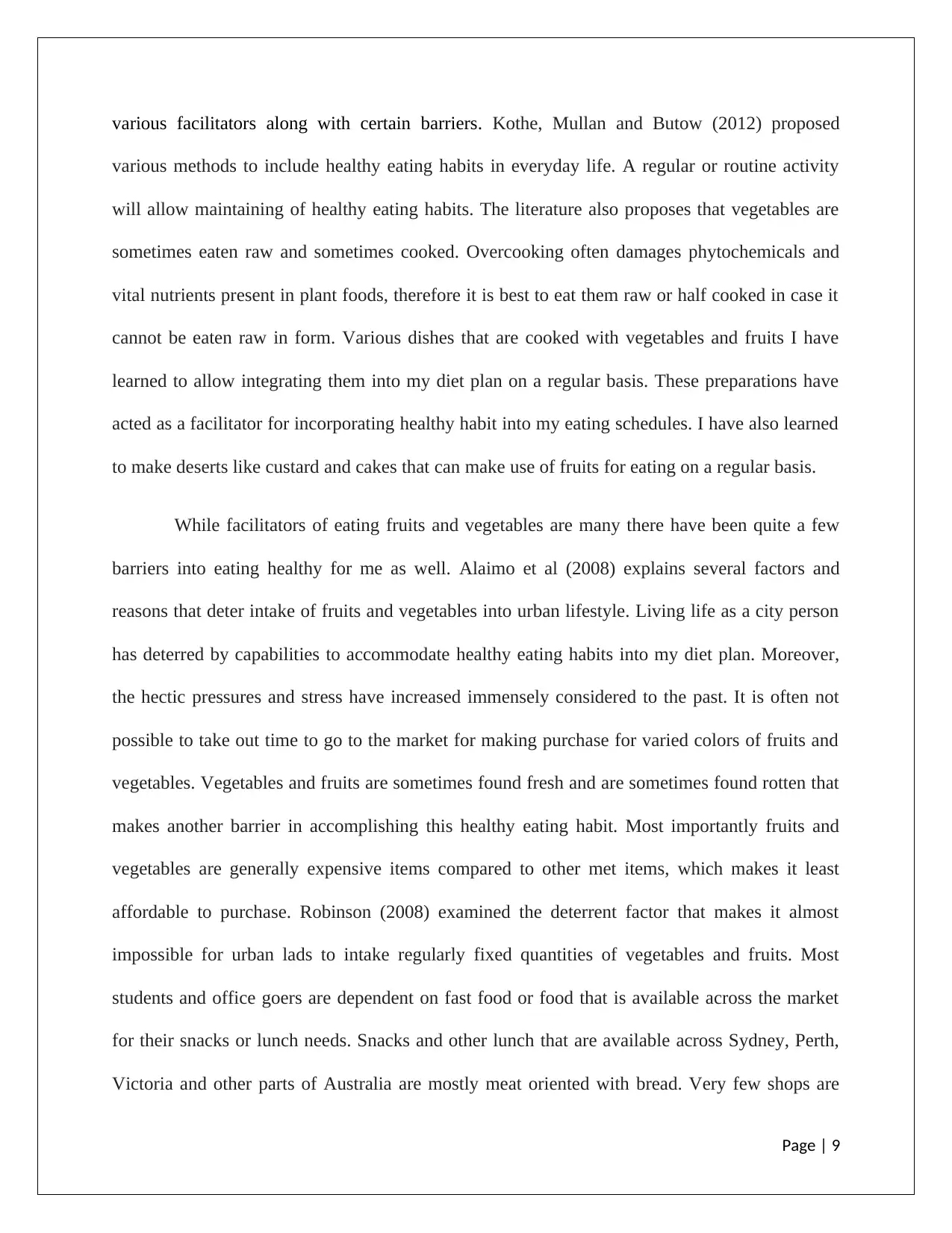
various facilitators along with certain barriers. Kothe, Mullan and Butow (2012) proposed
various methods to include healthy eating habits in everyday life. A regular or routine activity
will allow maintaining of healthy eating habits. The literature also proposes that vegetables are
sometimes eaten raw and sometimes cooked. Overcooking often damages phytochemicals and
vital nutrients present in plant foods, therefore it is best to eat them raw or half cooked in case it
cannot be eaten raw in form. Various dishes that are cooked with vegetables and fruits I have
learned to allow integrating them into my diet plan on a regular basis. These preparations have
acted as a facilitator for incorporating healthy habit into my eating schedules. I have also learned
to make deserts like custard and cakes that can make use of fruits for eating on a regular basis.
While facilitators of eating fruits and vegetables are many there have been quite a few
barriers into eating healthy for me as well. Alaimo et al (2008) explains several factors and
reasons that deter intake of fruits and vegetables into urban lifestyle. Living life as a city person
has deterred by capabilities to accommodate healthy eating habits into my diet plan. Moreover,
the hectic pressures and stress have increased immensely considered to the past. It is often not
possible to take out time to go to the market for making purchase for varied colors of fruits and
vegetables. Vegetables and fruits are sometimes found fresh and are sometimes found rotten that
makes another barrier in accomplishing this healthy eating habit. Most importantly fruits and
vegetables are generally expensive items compared to other met items, which makes it least
affordable to purchase. Robinson (2008) examined the deterrent factor that makes it almost
impossible for urban lads to intake regularly fixed quantities of vegetables and fruits. Most
students and office goers are dependent on fast food or food that is available across the market
for their snacks or lunch needs. Snacks and other lunch that are available across Sydney, Perth,
Victoria and other parts of Australia are mostly meat oriented with bread. Very few shops are
Page | 9
various methods to include healthy eating habits in everyday life. A regular or routine activity
will allow maintaining of healthy eating habits. The literature also proposes that vegetables are
sometimes eaten raw and sometimes cooked. Overcooking often damages phytochemicals and
vital nutrients present in plant foods, therefore it is best to eat them raw or half cooked in case it
cannot be eaten raw in form. Various dishes that are cooked with vegetables and fruits I have
learned to allow integrating them into my diet plan on a regular basis. These preparations have
acted as a facilitator for incorporating healthy habit into my eating schedules. I have also learned
to make deserts like custard and cakes that can make use of fruits for eating on a regular basis.
While facilitators of eating fruits and vegetables are many there have been quite a few
barriers into eating healthy for me as well. Alaimo et al (2008) explains several factors and
reasons that deter intake of fruits and vegetables into urban lifestyle. Living life as a city person
has deterred by capabilities to accommodate healthy eating habits into my diet plan. Moreover,
the hectic pressures and stress have increased immensely considered to the past. It is often not
possible to take out time to go to the market for making purchase for varied colors of fruits and
vegetables. Vegetables and fruits are sometimes found fresh and are sometimes found rotten that
makes another barrier in accomplishing this healthy eating habit. Most importantly fruits and
vegetables are generally expensive items compared to other met items, which makes it least
affordable to purchase. Robinson (2008) examined the deterrent factor that makes it almost
impossible for urban lads to intake regularly fixed quantities of vegetables and fruits. Most
students and office goers are dependent on fast food or food that is available across the market
for their snacks or lunch needs. Snacks and other lunch that are available across Sydney, Perth,
Victoria and other parts of Australia are mostly meat oriented with bread. Very few shops are
Page | 9
⊘ This is a preview!⊘
Do you want full access?
Subscribe today to unlock all pages.

Trusted by 1+ million students worldwide
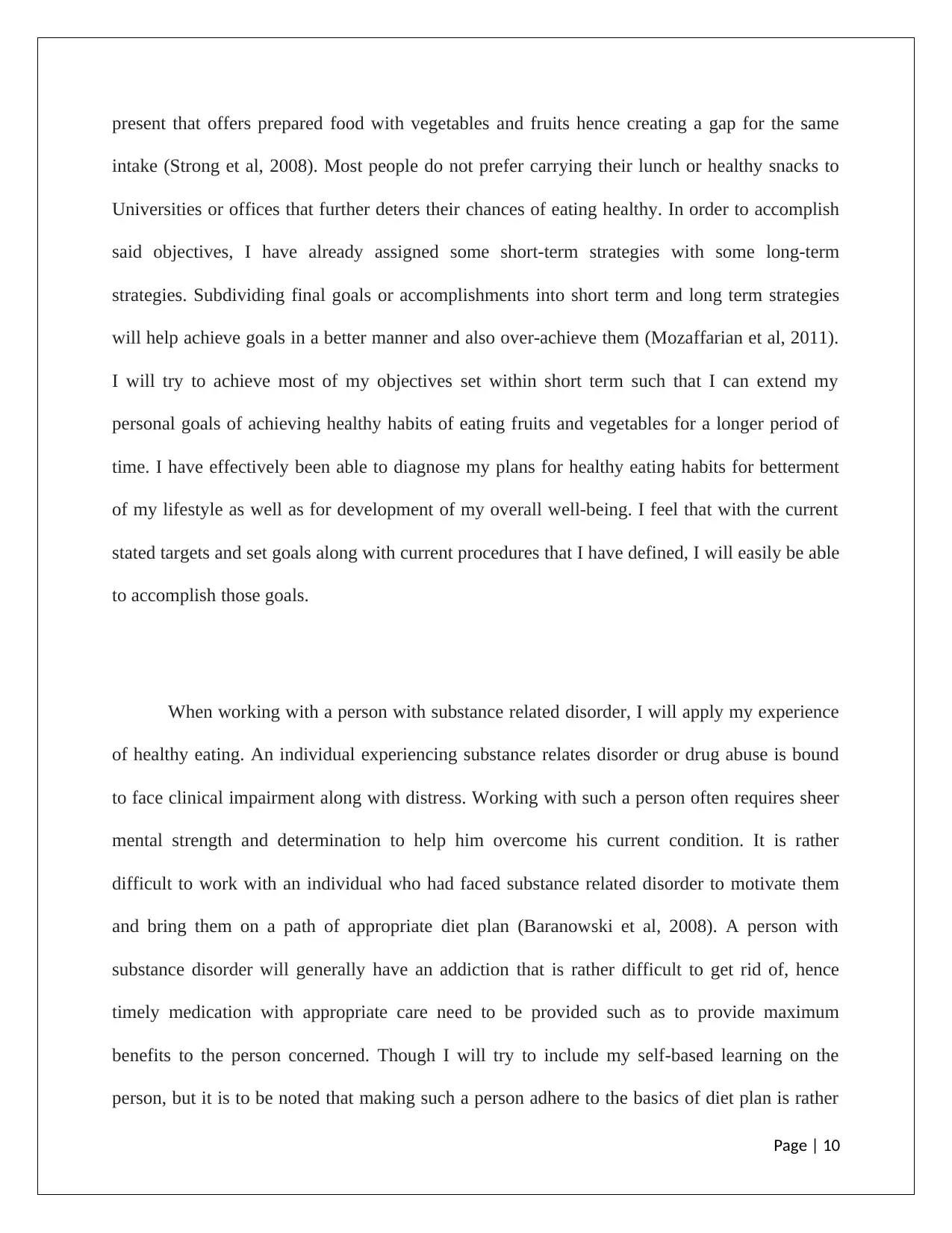
present that offers prepared food with vegetables and fruits hence creating a gap for the same
intake (Strong et al, 2008). Most people do not prefer carrying their lunch or healthy snacks to
Universities or offices that further deters their chances of eating healthy. In order to accomplish
said objectives, I have already assigned some short-term strategies with some long-term
strategies. Subdividing final goals or accomplishments into short term and long term strategies
will help achieve goals in a better manner and also over-achieve them (Mozaffarian et al, 2011).
I will try to achieve most of my objectives set within short term such that I can extend my
personal goals of achieving healthy habits of eating fruits and vegetables for a longer period of
time. I have effectively been able to diagnose my plans for healthy eating habits for betterment
of my lifestyle as well as for development of my overall well-being. I feel that with the current
stated targets and set goals along with current procedures that I have defined, I will easily be able
to accomplish those goals.
When working with a person with substance related disorder, I will apply my experience
of healthy eating. An individual experiencing substance relates disorder or drug abuse is bound
to face clinical impairment along with distress. Working with such a person often requires sheer
mental strength and determination to help him overcome his current condition. It is rather
difficult to work with an individual who had faced substance related disorder to motivate them
and bring them on a path of appropriate diet plan (Baranowski et al, 2008). A person with
substance disorder will generally have an addiction that is rather difficult to get rid of, hence
timely medication with appropriate care need to be provided such as to provide maximum
benefits to the person concerned. Though I will try to include my self-based learning on the
person, but it is to be noted that making such a person adhere to the basics of diet plan is rather
Page | 10
intake (Strong et al, 2008). Most people do not prefer carrying their lunch or healthy snacks to
Universities or offices that further deters their chances of eating healthy. In order to accomplish
said objectives, I have already assigned some short-term strategies with some long-term
strategies. Subdividing final goals or accomplishments into short term and long term strategies
will help achieve goals in a better manner and also over-achieve them (Mozaffarian et al, 2011).
I will try to achieve most of my objectives set within short term such that I can extend my
personal goals of achieving healthy habits of eating fruits and vegetables for a longer period of
time. I have effectively been able to diagnose my plans for healthy eating habits for betterment
of my lifestyle as well as for development of my overall well-being. I feel that with the current
stated targets and set goals along with current procedures that I have defined, I will easily be able
to accomplish those goals.
When working with a person with substance related disorder, I will apply my experience
of healthy eating. An individual experiencing substance relates disorder or drug abuse is bound
to face clinical impairment along with distress. Working with such a person often requires sheer
mental strength and determination to help him overcome his current condition. It is rather
difficult to work with an individual who had faced substance related disorder to motivate them
and bring them on a path of appropriate diet plan (Baranowski et al, 2008). A person with
substance disorder will generally have an addiction that is rather difficult to get rid of, hence
timely medication with appropriate care need to be provided such as to provide maximum
benefits to the person concerned. Though I will try to include my self-based learning on the
person, but it is to be noted that making such a person adhere to the basics of diet plan is rather
Page | 10
Paraphrase This Document
Need a fresh take? Get an instant paraphrase of this document with our AI Paraphraser
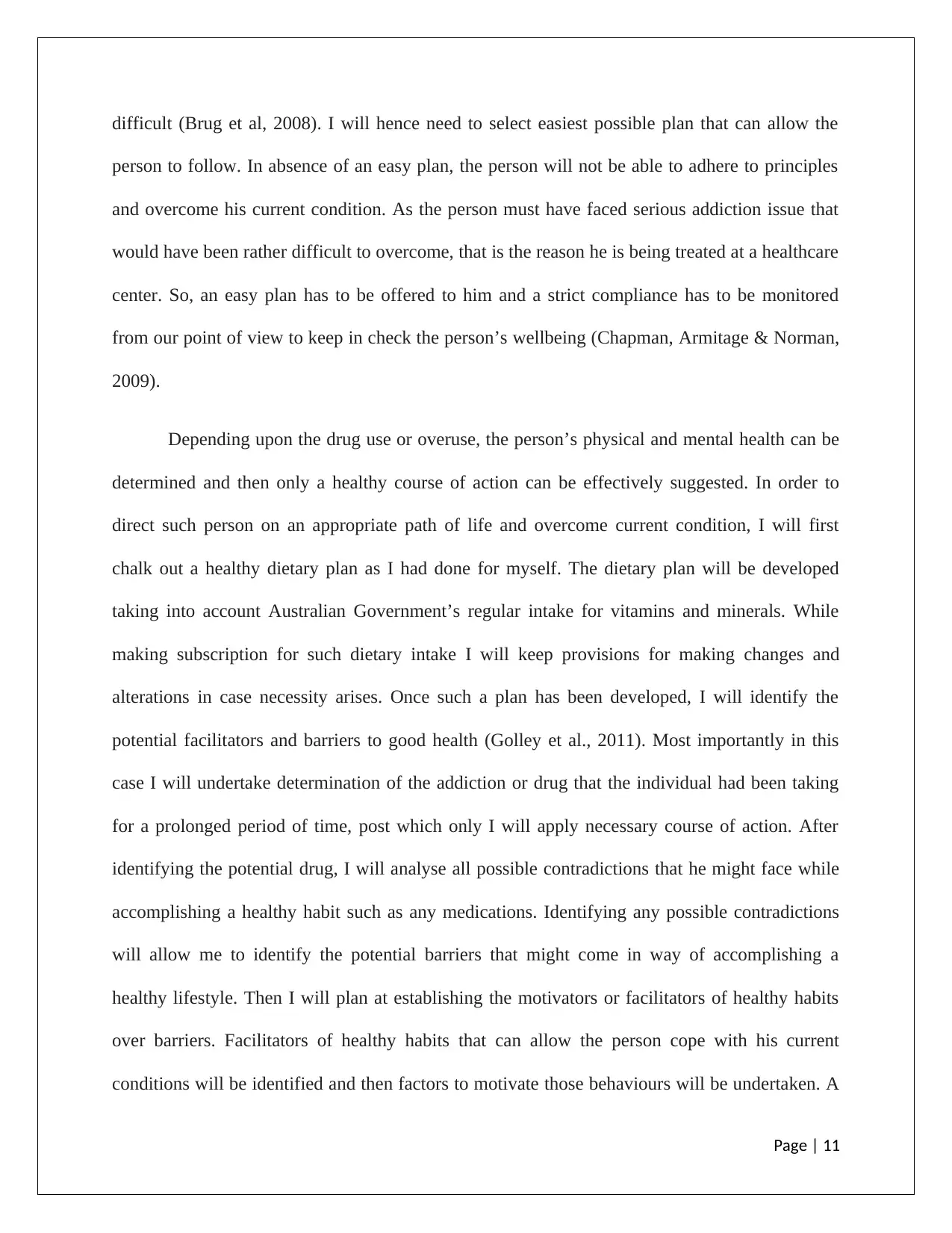
difficult (Brug et al, 2008). I will hence need to select easiest possible plan that can allow the
person to follow. In absence of an easy plan, the person will not be able to adhere to principles
and overcome his current condition. As the person must have faced serious addiction issue that
would have been rather difficult to overcome, that is the reason he is being treated at a healthcare
center. So, an easy plan has to be offered to him and a strict compliance has to be monitored
from our point of view to keep in check the person’s wellbeing (Chapman, Armitage & Norman,
2009).
Depending upon the drug use or overuse, the person’s physical and mental health can be
determined and then only a healthy course of action can be effectively suggested. In order to
direct such person on an appropriate path of life and overcome current condition, I will first
chalk out a healthy dietary plan as I had done for myself. The dietary plan will be developed
taking into account Australian Government’s regular intake for vitamins and minerals. While
making subscription for such dietary intake I will keep provisions for making changes and
alterations in case necessity arises. Once such a plan has been developed, I will identify the
potential facilitators and barriers to good health (Golley et al., 2011). Most importantly in this
case I will undertake determination of the addiction or drug that the individual had been taking
for a prolonged period of time, post which only I will apply necessary course of action. After
identifying the potential drug, I will analyse all possible contradictions that he might face while
accomplishing a healthy habit such as any medications. Identifying any possible contradictions
will allow me to identify the potential barriers that might come in way of accomplishing a
healthy lifestyle. Then I will plan at establishing the motivators or facilitators of healthy habits
over barriers. Facilitators of healthy habits that can allow the person cope with his current
conditions will be identified and then factors to motivate those behaviours will be undertaken. A
Page | 11
person to follow. In absence of an easy plan, the person will not be able to adhere to principles
and overcome his current condition. As the person must have faced serious addiction issue that
would have been rather difficult to overcome, that is the reason he is being treated at a healthcare
center. So, an easy plan has to be offered to him and a strict compliance has to be monitored
from our point of view to keep in check the person’s wellbeing (Chapman, Armitage & Norman,
2009).
Depending upon the drug use or overuse, the person’s physical and mental health can be
determined and then only a healthy course of action can be effectively suggested. In order to
direct such person on an appropriate path of life and overcome current condition, I will first
chalk out a healthy dietary plan as I had done for myself. The dietary plan will be developed
taking into account Australian Government’s regular intake for vitamins and minerals. While
making subscription for such dietary intake I will keep provisions for making changes and
alterations in case necessity arises. Once such a plan has been developed, I will identify the
potential facilitators and barriers to good health (Golley et al., 2011). Most importantly in this
case I will undertake determination of the addiction or drug that the individual had been taking
for a prolonged period of time, post which only I will apply necessary course of action. After
identifying the potential drug, I will analyse all possible contradictions that he might face while
accomplishing a healthy habit such as any medications. Identifying any possible contradictions
will allow me to identify the potential barriers that might come in way of accomplishing a
healthy lifestyle. Then I will plan at establishing the motivators or facilitators of healthy habits
over barriers. Facilitators of healthy habits that can allow the person cope with his current
conditions will be identified and then factors to motivate those behaviours will be undertaken. A
Page | 11
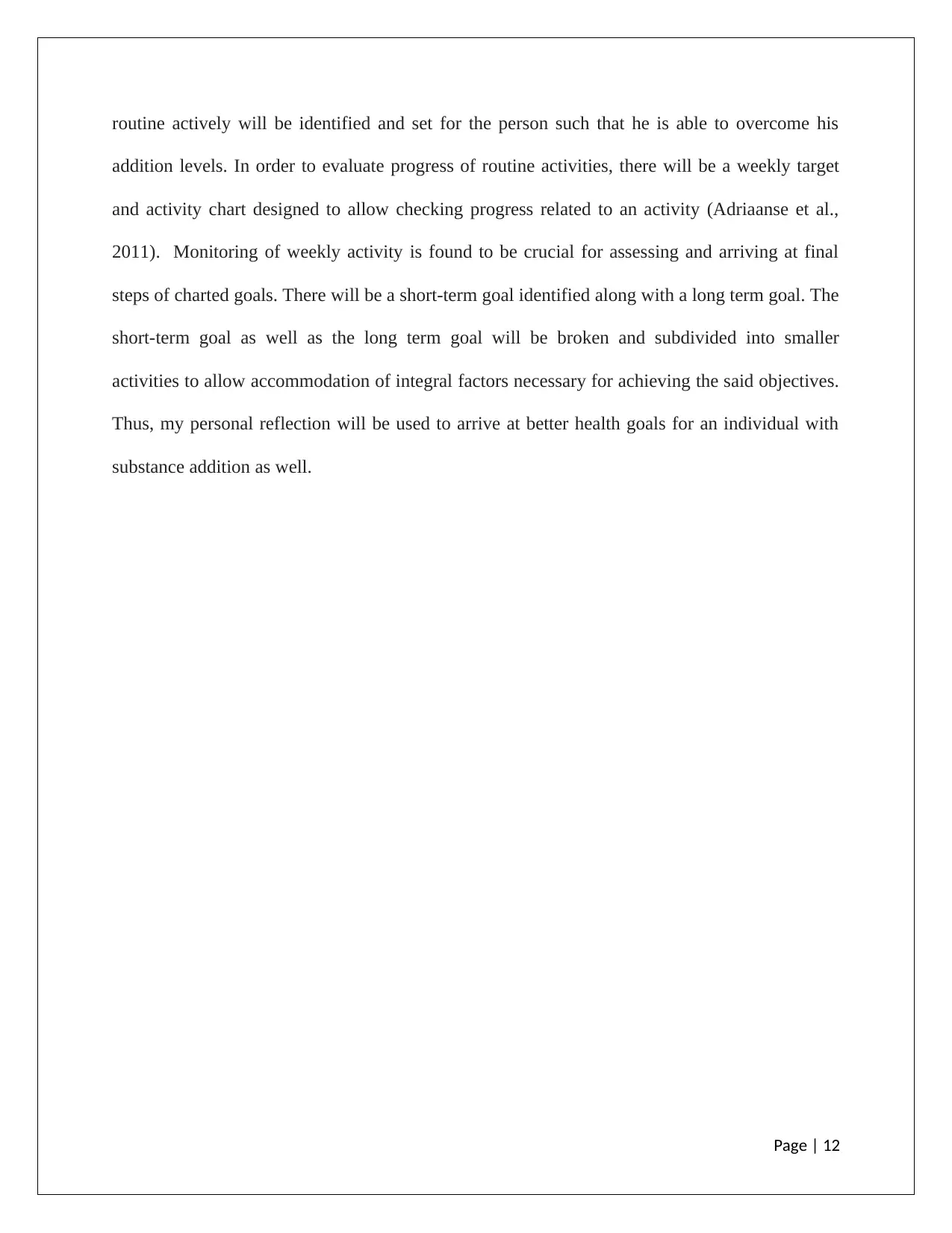
routine actively will be identified and set for the person such that he is able to overcome his
addition levels. In order to evaluate progress of routine activities, there will be a weekly target
and activity chart designed to allow checking progress related to an activity (Adriaanse et al.,
2011). Monitoring of weekly activity is found to be crucial for assessing and arriving at final
steps of charted goals. There will be a short-term goal identified along with a long term goal. The
short-term goal as well as the long term goal will be broken and subdivided into smaller
activities to allow accommodation of integral factors necessary for achieving the said objectives.
Thus, my personal reflection will be used to arrive at better health goals for an individual with
substance addition as well.
Page | 12
addition levels. In order to evaluate progress of routine activities, there will be a weekly target
and activity chart designed to allow checking progress related to an activity (Adriaanse et al.,
2011). Monitoring of weekly activity is found to be crucial for assessing and arriving at final
steps of charted goals. There will be a short-term goal identified along with a long term goal. The
short-term goal as well as the long term goal will be broken and subdivided into smaller
activities to allow accommodation of integral factors necessary for achieving the said objectives.
Thus, my personal reflection will be used to arrive at better health goals for an individual with
substance addition as well.
Page | 12
⊘ This is a preview!⊘
Do you want full access?
Subscribe today to unlock all pages.

Trusted by 1+ million students worldwide
1 out of 15
Related Documents
Your All-in-One AI-Powered Toolkit for Academic Success.
+13062052269
info@desklib.com
Available 24*7 on WhatsApp / Email
![[object Object]](/_next/static/media/star-bottom.7253800d.svg)
Unlock your academic potential
Copyright © 2020–2025 A2Z Services. All Rights Reserved. Developed and managed by ZUCOL.





